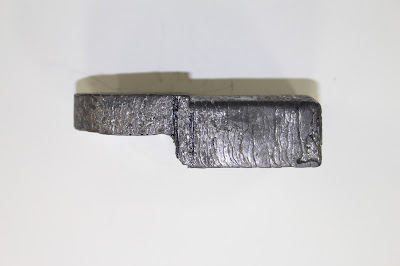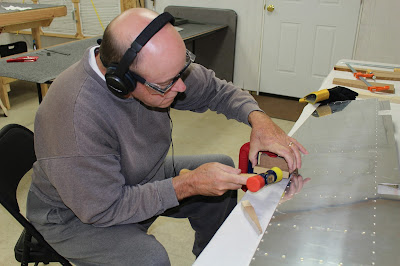In the course of going through the test fitting of the elevators, I learned much to my dismay that the holes I drilled in the elevator horns didn't align precisely enough with the center bearing race. The right one might have been close enough to use, but the left one was off by quite a bit. Apparently, the copper bushing I used during the drilling process, along with a taped-up #40 bit, wasn't accurate enough, and the problem was multiplied enough during the upsizing that the holes were off. I called Van's, and they said I needed to have the holes TIG welded closed, and then redrilled. Sure, that would mess up the powdercoating, but that could be primed over. Lots of other builders have gone through the same process, I was told. In the big scheme of things, the rework wasn't such a big deal, and it was worth it to have no binding in the elevator travel. They also made recommendations on some better bushing stock to use, which I did manage to find at one of my local hardware stores.
I got in touch with Jeremy Tingley, a local welder that came highly recommended. We discussed the project and the possibility that the weld might be difficult to drill through. He said he could use a softer alloy filler rod if necessary. I carefully wrapped up the elevators and headed to his home shop, where he got the job done in less than an hour.
Returning home, I set up to redrill the holes... and hit a hardened steel wall. The welds were an absolute monster to drill out. I went back to the hardware store and bought cobalt bits, but even those just sat and spun on the welds like an ice cube on a skating rink. In a panic, I did some more research, and learned that I should probably anneal the welds, but I don't have a torch that will generate that kind of heat. That would also burn the powdercoating, and possibly weaken the aluminum if the heat spread.
To make matters worse, during all the repeated remounting and removal the right elevator counterweight managed to hit the floor again. It was a light hit... but it did move the counterweight again, and when straightened I was left with two tiny cracks in the end rib webs. Damn! I got those stop-drilled and stabilized, but that didn't make me feel any better about the whole situation... which was starting to stink to high heaven.
I couldn't sleep that night... so I just went back out to the shop and continued to work on drilling until I got a small bit to penetrate each one. Using a lot of different methods, I did finally get both holes to size, and to my immense relief they were drilled straight and true. I got them prepped and primed, and the next day I reassembled all the empennage pieces onto the stand with the proper bolts and washers in place. I used standard nuts for the preliminary fitting, saving the locknuts for final assembly.
The following day I cleaned up the shop, and made up a cover for the vertical stabilizer assembly. The material I was going to use for the horizontal stabilizer covers was used up in masking and painting, and it seems that all the hardware stores no longer stock the size of padded ground cloth I had used previously. So I just cut an old fitted sheet in half, and used those to cover the horizontal stabilizers.
So things are buttoned up for now, and I think I'll leave them that way for a while. I need a break... or a break from breaking things... whatever.



























































